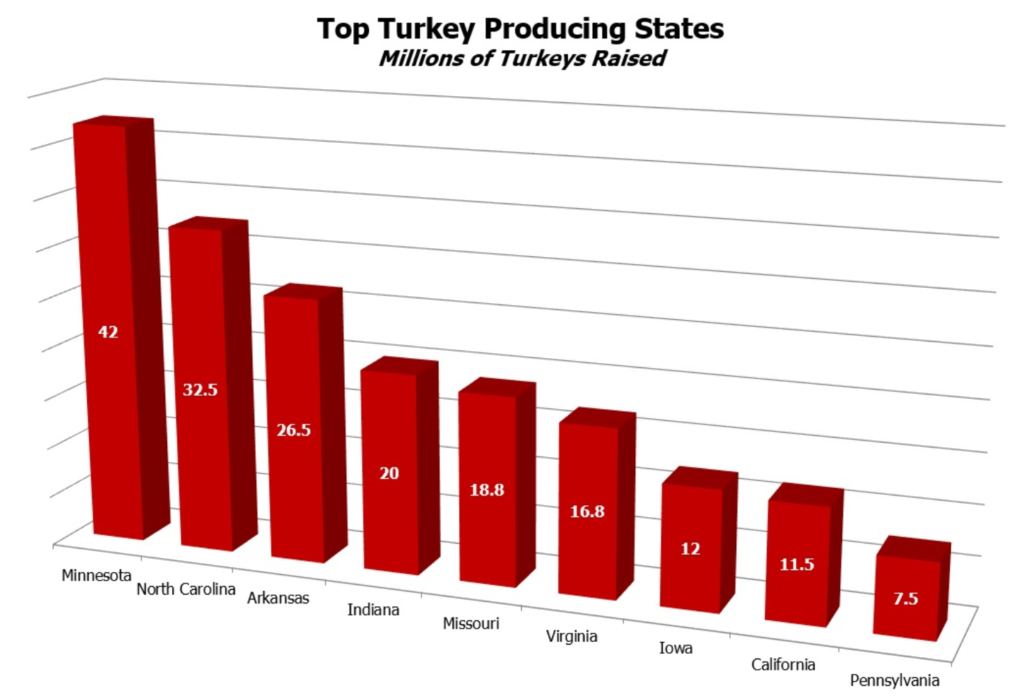Everything You Need to Know About Thanksgiving 2020, COVID-19 and the Supply Chain

Nowadays, modern Americans catch a lucky break during the Thanksgiving holiday. During the early days of this American holiday, families gathered and hunted for their own dinner, whereas today, we can rely on our local supermarkets to deliver the staples of our feast. However, preparation for the holiday, even for supermarkets, doesn’t happen overnight. Manufacturers, retailers, couriers, and supply chain managers begin preparations months ahead of November. This year they are also facing the extraordinary challenge of mitigating complex Thanksgiving supply chains in a COVID-19 world.
Here’s what you should know about Thanksgiving 2020, COVID-19, and the supply chain.
Supply Chain Manages Goods From Across the Country to Bring to Your Table
Holiday bounty comes from all across the country to end up at your dinner table. For example, in 2019 turkey was primarily produced in just five states. Minnesota alone raised 42 million turkeys for American families followed by North Carolina, Arkansas, Indiana, and Missouri respectively. Minnesota’s stronghold on turkey farming is even expected to withstand the COVID-19 pandemic, according to the Duluth News Tribune, and research done by the University of Minnesota. Sweet potatoes, another beloved holiday staple, is primarily produced in North Carolina. In fact, the state produces approximately sixty percent of all sweet potatoes grown in the country. While COVID-19 may not change the primary production locations of your Thanksgiving dinner, the same cannot be said for the amount of production, as discussed below.

Source: National Turkey Federation, Turkey Statistics, 2018
Supply Chain Aligns Cost Flows that Translate to Savings for Customers and Profits for Suppliers and Stakeholders
Another area where supply chain impacts your Thanksgiving meal is in your wallet. Supply chain managers work tri-fold to keep customers, suppliers, and stakeholders happy in this category. They are tasked with aligning cost flows and information to generate a profit margin for both suppliers and stakeholders, while ensuring that customers are satisfied with prices, as well.
According to the Farm Bureau Survey, for the third year in a row, Americans saw the cost of Thanksgiving dinner go down in 2018 to a grand total of $48.90. This was followed by a 1 cent increase in price in 2019. This year the American Farm Bureau Federation predicts that the average cost of Thanksgiving dinner will be $46.90 or 4% less than last year.
In part, this is thanks to ample supply and planning, but may also be due to smaller and less lavish Thanksgiving celebrations prompted by the pandemic and social restrictions. Whatever the reason may be, we’re still thankful for a less pricey dinner with loved ones.
Too Many (Big) Turkeys on the Supply Chain
It’s no secret that Thanksgiving will look a little different this year. Butterball, which is a company known for producing and selling turkey, among other poultry found that the number of consumers who plan to host non-household members for Thanksgiving has decreased to 26% from the usual 30%. Furthermore, they also cite that the number of individuals who plan to celebrate this year with immediate family only has increased by 10%. Fewer people at the Thanksgiving table roughly translates into less turkey to be consumed. People are expected to substitute away from larger turkeys and opt for smaller ones or turkey parts.
In fact, Drew Bowman of Bowman and Landes Turkeys told the Washington Post, that he fears that Bowman has too many large turkeys. Given the complex nature of turkey breeding, large turkeys can’t just be slaughtered earlier, which means there could be a surplus of leftover large turkeys after the holiday. In anticipation of smaller gatherings, large retailers like Walmart, have increased their assortment of bone-in and boneless turkey breasts by 20-30% in stores across the U.S.
Sides and More Sides
While turkey consumption is predicted to decrease this year, the same can’t be said for all of our other favorites such as mashed potatoes, green bean casserole, and mac and cheese. Given that many people are planning on just celebrating with their own households, an uptick in the number of novice Thanksgiving chefs is expected, which means pre-made side dishes will go fast. The Eater reports that Walmart, Kroger, and Publix may have to limit how many side dishes can be purchased per customer.
Thankful for Supply Chain
Regardless, Americans should still thank supply chain professionals for the joy they bring to our bellies across the country every year and especially this year. Remember that supply chains are agile in nature, and if this year has shown us anything, it is that supply chains can handle whatever is thrown at them.
Written by Maryam Noor
MSCM Writer & Content Strategist
[email protected]
